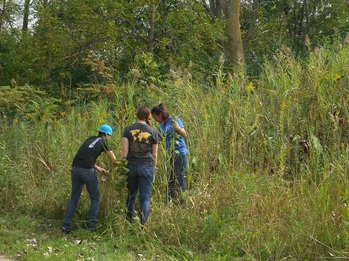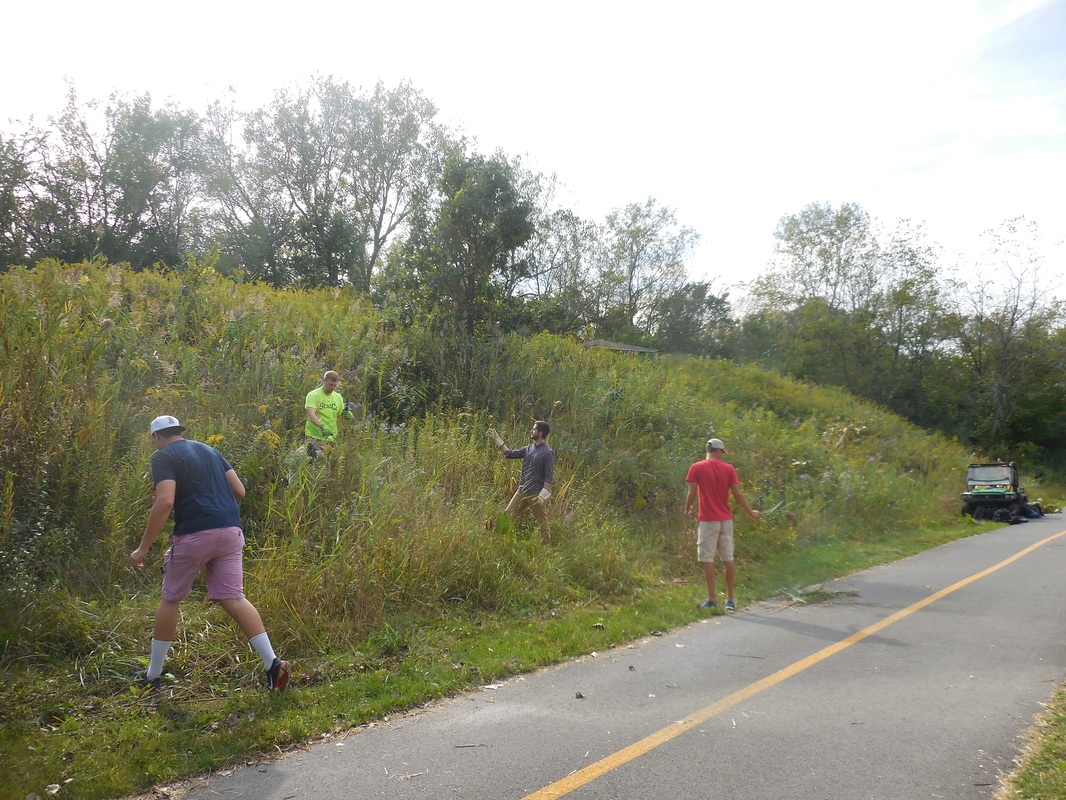|
This is a guest post written by a student in my Environmental Science class this fall. On the fateful afternoon of Thursday, September 24, 2015, the students in Environmental Science from Trinity Christian College marched toward Lake Katherine, led by their fearless leader, Commander S. While dodging cars and carrying their packs under the hot sun, the students were preparing for battle with the aliens that had landed next to the Cal-Sag trail. Upon arrival, they were greeted by the forward officer who had been holding down the fort, Shamim Graff. General Graff gave directions on how to identify the invaders who had camouflaged themselves into the hillside, and soon the battle began. But these aliens could not be fought with lightsabers or phasers – instead they had to be fought with clippers and gloves, for these aliens were not extra-terrestrial beings, they were invasive plants. Long before the Chicagoland was settled, the area now known as Lake Katherine flourished with native species: switchgrass, milkweed, oak trees, and many more. But as the area became more urban and people began planting foreign flowers and trees for aesthetic reasons, the native species began to disappear as the new species took hold, stealing valuable resources such as sunlight and soil nutrients. Buckthorn, Phragmites, and Teasel all began to grow, replacing the natural prairie with foreign plants. Because of this, efforts have been made to remove the invasive species, and promote native species, so that the natural ecosystem can continue to exist. Many animals and insects depend on the native species, and would die out with the native species. Removal of the invasive species allows the native species to get the sunlight and nutrients they need and have ample space to grow and flourish again. The battle was fierce. “These things are everywhere!” quipped Sergeant Brady Otte as he chopped down another Phragmites plume. One particular challenge was the steep slope on which the plants were growing. Students had to discern what plants were invasive as they clung to the side of the hill, wary of tumbling to the trail below. Luckily, no students fell as they worked, but many who had foregone gloves experienced small cuts on their hands, and students wearing shorts frequently checked for poison ivy. By the end of the day, the hill had been cleared of invasive species leaving the native plants behind, and the students were victorious. Commander S. gave the following summary during the victory celebrations: “It is really rewarding to see the work that can be accomplished with so many people working hard at removing the invasive species. By removing the shrubs that could shade the prairie, we are allowing a lot more light to reach the prairie plants, which will help them thrive.” Clearly the actions of the students had a positive impact on the ecosystem of the lake, and the students marched back to campus, celebrating their victory. ~Lucas Vander Wal
0 Comments
Leave a Reply. |
Abbie SchrotenboerI'm a biology professor at Trinity Christian College. I'll be using this page to share interesting stories related to ecology and conservation at Trinity and in the Chicago area (although I might be tempted to expand my geographic focus upon occasion). Archives
December 2020
Categories |


 RSS Feed
RSS Feed
